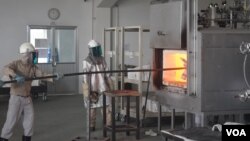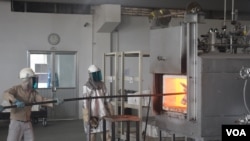After decades of solid growth driven by its garment industry, Cambodia is seeking to shift its economy into more sophisticated light manufacturing, such as electronics and auto-parts. Most of these manufacturers are Japanese and they are slowly coming online in Cambodia’s special economic zones, aiming to establish another hub in the regional supply chain.
Cambodia’s garment sector helped kick-start the country’s economy following decades of civil war and the atrocities of the Khmer Rouge.
Since the early 1990s, the industry has grown from about 1 percent of gross domestic product (GDP) to more than 10 per cent of GDP today. In 2015, Cambodia’s garment exports, shipped largely to the European Union and the United States, were valued at 5.7 billion, up by almost 7 percent on the previous year. Today, the industry employs more than 600,000 workers, mostly women, nationwide.
Along with agriculture and tourism, garment manufacturing has helped Cambodia’s economy to become one of the fastest growing in the region, averaging close to 7 percent yearly growth over the past 20 years.
But as impressive as it sounds, this economic expansion has come from a very low starting point. Although there has been a significant reduction in the poverty – in 2004 more than half the nation lived below the poverty line, by 2012 it was about 19 percent – much of the population sits just above that poverty line today, meaning Cambodians are vulnerable to economic slowdowns.
To maintain its growth momentum, the government is seeking to expand its manufacturing base, moving away from dependency on garments and aiming to attract more sophisticated manufacturers, like auto-parts and electronics producers, whose know-how leads to an upgrade in local skills and eventually higher wages.
“We have to have development of the industrial sector, meaning manufacturing,” said Mey Kalyan, a senior advisor to the government’s Supreme National Economic Council. “Meaning what ever sectors support the industries in Cambodia, because any country, you can not develop a country on agriculture and tourism alone.”
In order to draw these light-manufacturers the government is aiming to reduce notoriously high energy costs, strengthen the level of skills for those entering the workforce, and improve roads and ports so that Cambodia can play a larger role in a regional supply chain that supports auto-manufacturers, according to Kalyan.
“We have to connect with the production base in Thailand, which is mainly focused on auto, and other light-manufacturing,” he added.
Infrastructure Improvements
Plans are underway to enhance roadways, or to construct a belt, that runs from the Vietnamese border in the southeast, through Phnom Penh and up to the Thai border in the northwest. There is also a focus on upgrading Cambodia’s largest port, in Preah Sihanouk province, to enhance shipping to Malaysia, Singapore, Indonesia and even Japan and China.
But some investors haven’t waited for the logistical improvements.
Over the past few years, a handful of Japanese light manufacturers have started production in Cambodia, including auto-components and electronics.
One of the light manufacturing pioneers is the Japanese-owned Nikko-Kinzoku, which produces heat-resistant steel baskets to transport and store auto-parts.
Some 60 Cambodian employees work at the factory located inside Phnom Penh’s most developed special economic zone, with the products playing their role in an automobile supply chain that leads to Japan.
Yoshiyuki Sato, president of Nikko-Kinzoku in Cambodia, says that rising labor costs in traditional manufacturing hubs like China, coupled with a need to spread business risk across multiple bases, has manufacturers seeking alternative Asian countries in which to set up shop.
“If we focus on Asia, Thailand also is a little bit expensive,” Sato said. “Therefore we try to choose a cheaper labor cost,” he added, referring to Cambodia’s labor market.
Obstacles
But there are still many obstacles to overcome.
According to an Asian Development Bank survey of factories inside Cambodia’s special economic zones, corruption, low levels of education, as well as expensive and unstable electricity are ongoing constraints to business.
“Trade facilitation must be improved to reduce costs and delays associated with importing and exporting,” said the ADB report, which was released last year. “Corruption must be reduced and rules of payment to government agencies clarified,” it continues.
The ADB found that “electricity supplies must be improved.”
But the bank said the most important hurdle for Cambodia is an educational upgrade for its workforce. “Most important, but most difficult, labor quality must be improved by investment in basic literacy and numeracy,” the report concluded.
But despite the competition to attract investors from more mature manufacturing sectors like neighboring Thailand and Vietnam, Cambodia is well positioned to play a major part in the regional supply chain, said Chan Sophal, director of the Center for Policy Studies for Cambodia Development.
“The industrial approach by major manufacturers is that they take a cluster approach, so they may have parts produced in Thailand, but some produced in Cambodia, some in Vietnam,” he said. “They know how to place their factories to get the most out of the advantage of their location and their conditions.”
Analysts say that policy makers will need to ensure red tape is cut and the regulatory environment stable if the country is to take a similar development pathway as China and Thailand, and one day become a major manufacturing hub in Asia.











